Ableism and Ageism in One Tidy Little Package
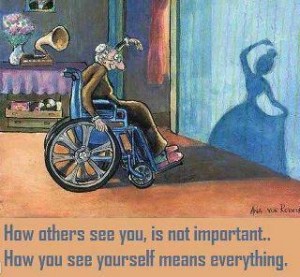
Source: Facebook
I have only two positive things to say about this graphic:
a) I’m sure the person who put it together had the best of intentions.
b) I love the Victrola in the background.
Now for my critique. Let’s start with the text:
How others see you, is not important.
How you see yourself means everything.
The text is meant to inspire and support us in laying claim to our own self-representations. Okay. Fair enough. It’s abundantly true that my own sense of myself should be more important than other people’s ideas about me. People have told me such things from the time I was a small, sensitive child, overwhelmingly in tune with what people thought about me. What they didn’t tell me was how much my sense of myself and other people’s sense of my self were intertwined. I’ve since realized, of course, that most of us get our ideas about ourselves as a result of how others look at us, how they treat us, and whether they respect and value us. If you’ve been victimized, or bullied, or misrepresented, or otherwise had your sense of yourself messed with, it’s necessary to reclaim your sense of who you are, but it generally doesn’t happen in a vacuum. It takes the support of other people giving you a relatively undistorted mirror in which to see yourself. The need for such a mirror is why I read so widely about the experiences of other disabled people, why I read every piece of disability theory I can get my hands on, and why I have so many disabled friends. If I didn’t, I might actually believe the things that people say about disability.
Which brings me to the question of what people say about disability, and how the graphic uses disability and aging for the purposes of inspiration. The elderly woman in the wheelchair represents the first part of the text: How others see you. What do they see? Literally speaking, they see an elderly woman in a wheelchair. Of course, no one except a Zen master sees anything literally without attaching to it some value or interpretation, so there is a symbolic meaning attached to being elderly and disabled that makes being elderly and disabled a bad thing. Why do I draw the conclusion that a negative meaning has been attached? Because the first part of the text, How others see you, is placed in contrast with the second part of the text, which talks about what’s really important: How you see yourself. The message is that if people see you in a bad light, what’s most important is that you see yourself in a good light. Apparently, to be old and disabled is to be seen in a bad light.
What does one do in such a predicament? Why, one just imagines oneself as a young, typically able-bodied dancer with an hourglass figure — perhaps a former self that no longer exists, perhaps a fantasized self that never existed at all. Apparently, this kind of imagining is what is means to see oneself in a good light. The message is that young able-bodied dancers with hourglass figures are worthy of esteem, but elderly disabled people in wheelchairs are… not. If you are old and disabled, then, and you want to have healthy self-esteem, you need to imagine that you are someone else. I’m not clear on how one does such a thing without losing touch with the reality of one’s own existence, or without becoming so psychically estranged from oneself as to create an unhealthy amount of stress and self-hatred. Perhaps someone can explain that to me. My attempts at pretending to be someone else have generally been met with anxiety and ill health.
At any rate, it’s clear from the graphic that the association of being old and disabled with low self-esteem is simply a given. It is never questioned. It is assumed that there is something essential about aging and disability that is in itself degrading. No attention is paid to the fact that feelings of degradation have their roots in a cultural rejection and abasement of elderly and disabled people. As Susan Wendell points out, we live in a culture with a nearly pathological desire for control, which causes most people to reject people who show signs of aging and disability:
Disability tends to be associated with tragic loss, weakness, passivity, dependency, helplessness, shame, and global incompetence. In the societies where Western science and medicine are powerful culturally, and where their promise to control nature is still widely believed, people with disabilities are constant reminders of the failures of that promise, and of the inability of science and medicine to protect everyone from illness, disability, and death. They are ‘the Others’ that science would like to forget (Wendell 1996, 63).
The symbolic meanings associated with aging and disability — loss, weakness, dependence, and death — provide both an incentive and a justification for rejecting elderly and disabled people. These meanings spare the able-bodied the responsibility for acknowledging the vulnerability of their own bodies, allow them to deny that they could become disabled at any time, and provide a way for them to distance themselves from the inevitability of death (Wendell 1996, 60). Once these meanings are in place, the burden falls on the shoulders on elderly and disabled people to solve the problem of becoming devalued and unwanted. This state of affairs is apparent in the graphic, as the onus is on the elderly woman to imagine herself to be someone else, rather than on other people to see her — and to treat her — as someone who is beautiful, valuable, and respected.
Forcing minority people to shoulder this burden is a process deeply entrenched in our culture. The aim of many professionals is to get us to adjust to our lot in life by changing our own attitudes and perspectives, rather than by fighting to change the attitudes and perspectives in the world at large that cause us so much grief and pain. When my disabilities became apparent in mid-life, I went through a great deal of sadness and frustration over both my physical difficulties and my social exclusion. The ways in which our society treats disabled people were weighing heavily on me, but my therapist insisted that I simply needed to find better coping mechanisms. At one session, I constantly challenged him with a version of “But why is it solely my responsibility to handle exclusion, and not the responsibility of the people who engage in it?” In response, he simply repeated the phrase “It’s your problem,” as though I were missing a necessary piece of wisdom that only repetition would make clear. Needless to say, that was our last appointment.
Of course, I am not at all opposed to disabled people developing coping mechanisms. That’s a necessity. What I oppose is ignoring the conditions in the world at large that force us to spend so much time and energy developing coping mechanisms in the first place. And I resist the idea that imagining oneself to be a member of the unstigmatized majority is a healthy way to deal with stigma. Rather than fantasizing about being someone else, we ought simply to demand that people respect us for who we are.
References
Facebook. http://www.facebook.com/photo.php?fbid=10150887120344632&set=p.10150887120344632&type=1&theater. Accessed June 21, 2012.
Wendell, Susan. The Rejected Body: Feminist Philosophical Reflections on Disability. New York, NY: Routledge, 1996.
© 2012 by Rachel Cohen-Rottenberg




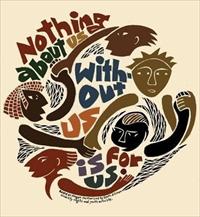
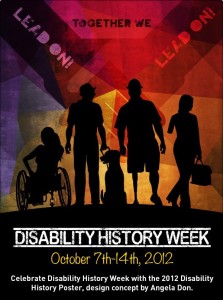
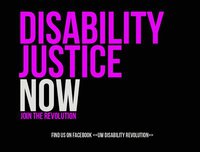
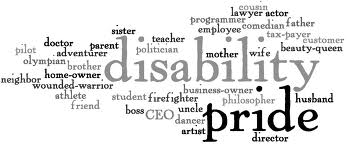

LucyMB
6/22/2012 | 1:11 pm Permalink
Great piece. You’re right of course, the internal transition can’t happen without external support.
Can I just add a critique you missed: that comma in the first line — what the hell is that about?
Rachel Cohen-Rottenberg
6/22/2012 | 1:33 pm Permalink
Yes, my editor’s eye went to that as well. I decided to concentrate on the content.
DENA
6/27/2012 | 12:14 pm Permalink
What I see is an elderly lady who is remembering when she was an accomplished ballerina. She is playing her music on her victrola and seeing her younger self. The smile on her face shows her happiness at the memory. She is not trying to instill the thought into anyone elses mind. I may not have a masters degree but I do know what (I) see.
Rachel Cohen-Rottenberg
6/27/2012 | 1:19 pm Permalink
Dena, for any image, there are multiple interpretations possible. If you’ll note, I suggested the possibility that the elderly lady was thinking of a former self. There is nothing wrong with doing so if one is simply enjoying a happy memory. However, the text overlays a value onto the image, and it draws a contrast being the perceptions of others, in which being old and disabled is a bad thing, and one’s self-perception, in which being young and able-bodied is a good thing. It’s the devaluation of being old and disabled that I’m critiquing here — not whether it’s okay to enjoy a happy memory. As I age, I get a great deal of sustenance from my memories. That’s very different from feeling good about myself by imagining myself as a young woman when I’m in my mid-50s. I’m not a young woman, and in order to feel good about myself, I have to feel good about who I am right now, not about who I once was.
And just to be clear: I don’t judge the validity of an interpretation based on credentials, so whether you have a master’s degree or not really isn’t important to me. I judge the validity of an interpretation on its merits; people are free to disagree with my interpretations whenever they see fit, and I will listen and reflect. If someone has a credential that gives that person a particular expertise and insight into something I’m saying, I will respect that, but I won’t automatically agree with the person or assume that the person must be right.
Happy Elf Mom
6/22/2012 | 2:46 pm Permalink
Interesting, because as I saw this picture before on fb, I “liked” it very much. I thought of it as showing the inner life and creativity of the person that is unchanged within … and hadn’t considered that this was really a “pretend you are someone else less old and disabled” sort of a picture at all. And then I thought that someone should totally take her to the ballet because she would enjoy it so, have you seen the new “spaces” between standard seats for wheelchairs? Such a simple accomodation, and yet why didn’t anyone think to do it before?
Anyway, it’s a great post and it’s very applicable to me as I raise teens and tweens who are going to need to find their place in the world and change it, all at the same time. That part I totally agreed with and understood.
maylislovingthings
6/23/2012 | 5:45 am Permalink
I like this post but this was not my interpretation of this graphic the first time I saw it. And even if I understand what you mean… I still see this graphic as a positive message… maybe because my biggest frustration in life is not beeing able to do ballet dance. I accept myself as a disabled woman and sometimes I like thinking about How my life could be if I was able bodied… and most of the time I think that I would be a totally different person… and not only in a good way… and it makes me appreciate who I am, partly thank to my disability…
Anyway thank you for sharing your thoughts and your knowledge, I love your blog!! it often rings a bell and makes me think of things in other ways! Merci!!
ps : sorry for the grammar mistakes, I’m french…
GirlWithTheCane
6/23/2012 | 11:57 am Permalink
The graphic left me cold and I couldn’t say why. Then I totally got onto your train of thought and found myself anticipating what you were going to say next…and yeah, the graphic left me feeling kind of…icky.
The second part of your post spoke to me about locus of control, and it really made me think. I’ve been known myself to say to people with disabilities that I’ve worked with, “Focus on what you can control. You can’t control that person’s ignorant atttitude and what it makes him say; you can only control how you react.” But you’re right that it does put all the onus on the person with the disability to develop a thick skin. Perhaps a better way for therapists is to assist the person to develop coping strategies while helping them to explore what they feel they can do in their circumstances to feel like they’re contributing to changing peoples’ attitudes?
Rachel Cohen-Rottenberg
6/23/2012 | 12:28 pm Permalink
Yes! I worked with a therapist for awhile who is very aware of disability rights issues, and we talked a lot about the work I do with my writing. She was very supportive of my truth that most of what depresses me has to do with stigma and discrimination, and with the ways in which I’ve internalized negative attitudes about disability from the world around me. By the time I went to see her, I had largely adapted to my disabilities, so the question really became how to navigate other people’s attitudes. In a lot of ways, our discussions of the work I do with my writing helped me to claim the value of my form of activism, and to develop pride and inner strength to deal with what the world dishes out. What was most helpful was realizing that I didn’t have to be doing the sort of activism that, given my sensory issues, would be very difficult — like taking a bus to protests or talking with my legislators — and that simply speaking out in my own voice was enough.
Sharon daVanport
6/23/2012 | 12:57 pm Permalink
Love this, Rachel! I appreciate your post, and I love the direction your work is going. These are important topics to bring to light and understand – thank you.
EAPC
4/2/2013 | 3:35 pm Permalink
Interesting….. I’ve seen this picture before (since this is almost a year old posting, I’m sure that’s not surprising) but I liked it. I didn’t go to any of the places about being old and in a wheelchair being negative (especially the chair – it didn’t even really register to me that it was a wheelchair versus just some nondescript hospital/nursing home/grandma’s kitchen chair), or that the ballet shadow was an idealistic anything. I thought it was just a commentary on human imagination. If that shadow had been of a seated racecar driver, or a fairy, or sasquatch or any other number of different fantastic shadows rather than of a dancer, maybe you’d have seen it in the same light I did. I suppose that’s why you put that part in your post about monks and not making value judgments based on appearances, but I hope there are more people out there than Buddhist monks (and me) who just see it as a flight of imagination being projected there rather than an escape from perceived restrictions. I’m sort of a day dreamer, though, and I dig the quote. I might look like an absolutely average, tame, frumpy librarian type to others, but I’m a rock star in my own head any time I feel like being one.
I guess I just wanted to throw in some optimism to counter the criticism there….. I don’t see it the way you’ve described it at all, and I’m sure I can’t be the only one. People aren’t ALL full of negative stereotypes and assumptions.
Trackbacks & Pingbacks
[...] kind), but i don’t sugarcoat things, either. several people have written really great posts about why inspiration porn is hurtful, and i don’t want to regurgitate that here, but i do [...]
[...] Personally, I really liked this model of disability, and I like the idea that sometimes a change in perspective can make the difference between ability and disability. It matches my perspective on ASDs, so it [...]